Well, so much for the trees.
After leaving Cottonwood and its relatively leafy environment, we headed to northeastern Arizona, where the Colorado Plateau put us at relatively high elevation but in an arid desert environment with virtually no trees in sight. The flat, scrubby high plains just go on forever. We were scheduled to be back in wooded areas soon, so there was an end to our arboreal withdrawal in sight, and during our stay we tried to appreciate the beauty of the harsh environment around Winslow.
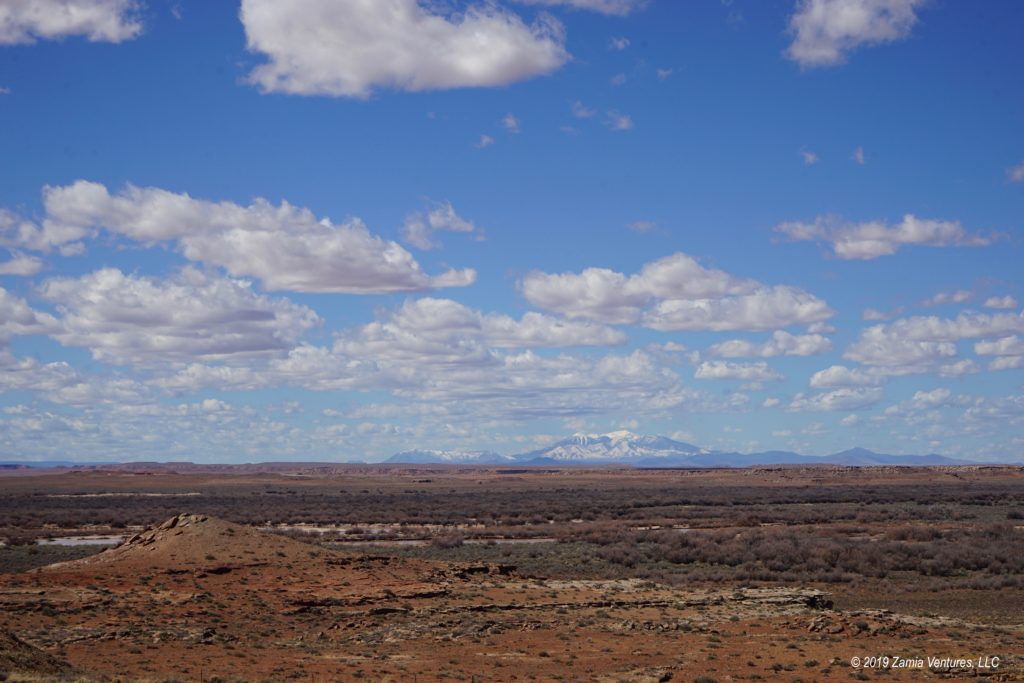
Petrified Forest National Park
One of our main destinations in the area was Petrified Forest National Park. Full disclosure: we are not all that interested in petrified wood. We’ve seen it on plenty of trails and found it mildly interesting, but we are not rockhounds in general, and petrified wood in particular does not amaze and delight us. The thought of a park comprised of 150,000 acres of petrified forests was not overly appealing to us, but we headed out to the park for our 18th national park (and 57th National Park Service unit) visit anyway.
We should have had more faith in the National Park Service. Every single national park we have visited so far has been remarkable in some way, and Petrified Forest was no exception. The park includes a large swath of Arizona’s Painted Desert, a badlands area where erosion has revealed colorful sediments in a rainbow of colors. We particularly liked the purplish tones of the Blue Mesa area and the crimson hues seen from the Painted Desert Inn. Like in our prior visits to Badlands National Park and John Day Fossil Beds National Monument, our minds had trouble processing the unusual landscape: “Why is everything so crumbly? And weirdly colored?”
In addition to the natural wonders, the park also preserves a wide variety of cultural history. There is a 14th century pueblo on a hillside along the Puerco River, which is little more than a ruin but an important reminder of the long history of human habitation in the area. Many generations of people left their mark in the form of striking petroglyphs, including the very well-used Newspaper Rock and a petroglyph that works with a crevice in a boulder to mark astronomical time when the sun shines directly through the crack on solstice days.
More modern human use is also preserved along the historic location of Route 66, which passed through the park and is commemorated by a 1932 Studebaker frame and the retention of the old telephone poles that lined the route. The Painted Desert Inn, a national historic landmark that was a popular stopping point along Route 66, has been beautifully preserved within the park and now houses a small museum.
The gorgeous, colorful vistas and vivid cultural history were so interesting that we didn’t even mind stopping to look at piles of petrified wood. Maybe our judgment was clouded by all the other great things the park offers, but we even found some of the petrified wood to be fascinating, with its array of colors and the appearance of perfectly sawed logs.
Standin’ on the Corner
Fine, so we stood on a corner in Winslow, Arizona. More accurately, one of us did. The tiny downtown area of Winslow, Arizona has parlayed its bit part in the Eagles song “Take It Easy” and its location along historic Route 66 into becoming a minor tourist attraction. The emphasis is on the “minor.” Standin’ on the Corner Park features a trompe l’oeil mural with images from the Eagles song and a sculpture of a 1970s dude with a guitar, along with a modest stream of visitors having their photos taken. Meanwhile, the rest of the businesses in the tiny downtown area include Sleeping on a Corner Motel and numerous gift shops selling tchotchkes related to the Eagles, Route 66, and the movie Cars. I would call it a tourist trap, except that there were so few visitors on the street mid-day on a weekday that the place is not even a very effective “trap.”
La Posada & The Turquoise Room
I was excited to visit the main historical site in Winslow, the historic hotel La Posada, because of my new-found love for architect Mary Jane Colter. The story of Mary Jane Colter starts with the Fred Harvey Company, which partnered with the Atchison, Topeka & Santa Fe Railway to make rail travel to the west a more appealing prospect. The ATSF Railway wanted to increase passenger traffic on its lines, and realized that the rancid food served by random eateries along the railroad route and overall discomfort of the journey was holding all but the most adventurous people back from traveling. The railroad worked with Fred Harvey, an innkeeper in Topeka, to establish a chain of hospitality stops that made the journey much more tolerable. The Fred Harvey Company started by offering high quality, efficient meals served as soon as the train arrived in each stop — served on china and linen, no less! — and from its inception in 1876 in Topeka the company grew to 45 restaurants in 25 years. The Harvey Houses were America’s first restaurant chain, and eventually expanded to include other hospitality options like hotels.
Mary Jane Colter was the chief architect and designer of The Fred Harvey Company from 1910 to 1948. During that time she personally designed or oversaw the creation of hundreds of iconic hospitality stops. Her work was notable for incorporating the styles and motifs of the southwest, especially Spanish and Native American designs. Instead of just building facilities that would have looked typical in any eastern setting, Colter really made her buildings fit into the landscape so travelers could feel the soul of the place they were visiting. And unlike most contemporary architects, she designed much more than just the structures. She also designed furnishings, interior decoration like flooring, and even small items like china and utensils. She was at the helm when The Fred Harvey Company completed its finest work: designing the hospitality structures at the Grand Canyon. Mary Jane Colter personally designed the Bright Angel Lodge, Desert View Watchtower, Hermit’s Rest, and the Phantom Ranch on the floor of the canyon. Her work on Phantom Ranch was so well-suited to the location that it became the inspiration for all future development in national parks. That distinctive “parkitecture” style used by the CCC in the 1930s and in virtually all subsequent national park structures came directly from the specific design choices of Mary Jane Colter. Interestingly, the Fred Harvey Company is still a leader in national park hospitality. National park visitors will recognize it by its current name: Xanterra.
Colter considered La Posada, a large Fred Harvey Company hotel in Winslow, Arizona to be her finest work. Unfortunately the hotel opened shortly after the 1929 stock market crash, and faced difficulties during the Depression and from the subsequent decline in train travel. The hotel was closed in 1959 and used as railroad offices until being shuttered in 1994. The property was purchased by investors in 1997 and has been lovingly restored to its original glory. While the Colter-designed furnishings were auctioned off in the 1950s, the current owners have managed the fill the lobby spaces with remarkable items that capture the spirit of the original hotel as seen in the historic photos placed throughout.
We stopped by La Posada one day for lunch to eat in the Turquoise Room restaurant in the hotel, notable for its southwestern cuisine. Our meal certainly lived up to the hype. The most unusual thing we tried was an appetizer of piki bread and “Hopi hummus.” Piki bread is a traditional Hopi item made from ground blue corn and ash, spread so thin on the cooking stone that it becomes tissue-paper thin. The resulting thin tortilla is loosely folded into a small roll before it cools. The accompanying hummus was made from tepary beans, the beans grown by the ancient desert farmers like the Ancient Sonoran Desert People and the Ancestral Puebloans. The combination was unusual and delicious. Ken liked the flavors in his steak lettuce cups and spicy beans. My pork carnitas were really good, but for me the tamale was the absolute star of the show. Our little stop at La Posada was a highlight of our stay in Winslow.
Homolovi State Park
During our stay in Winslow we camped at Homolovi State Park, located just outside of town. The location was convenient to the places we wanted to visit, but had several pros and cons.
The good: This lightly-used state park has no trees to speak of, but since the park was mostly empty during our visit we didn’t feel like we were on top of our neighbors. The wide open views were nice during the day, and seeing trains in the distance put us in touch with Winslow’s past as a railroad hub. The big skies offered views of the distant San Francisco Peaks, and some nice sunrises and sunsets, and at night we had a few decent stargazing opportunities.
The bad: Holy crap is it windy here! We had three solid days of winds gusting at 40-50 mph, which had our whole trailer rocking despite our relatively aerodynamic shape. It was so windy that it was difficult at times to open our door and even to walk upright across the campground. No wonder there are no trees here! Also, the ruins that are the centerpiece of the park were pretty similar to other pueblo ruins we’ve seen, with the only distinguishing feature being that there are many pottery shards on the ground. In many places prior visitors collected shards on flat rocks, and while it was interesting to see the different pottery colors and designs, these ruins were not all that compelling.
Next: we head to Flagstaff, where we will test the ability of our trailer to handle wintry conditions.
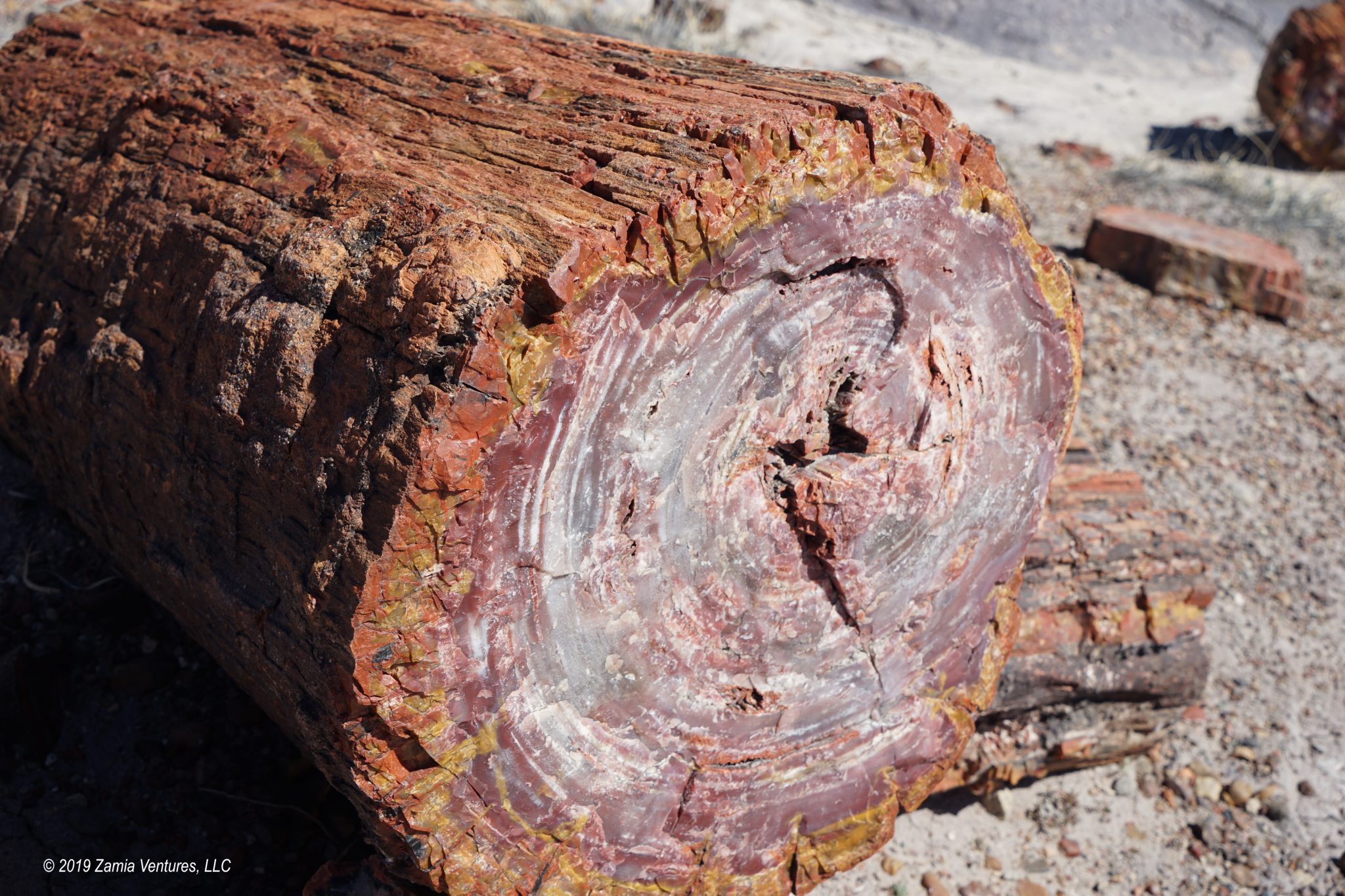
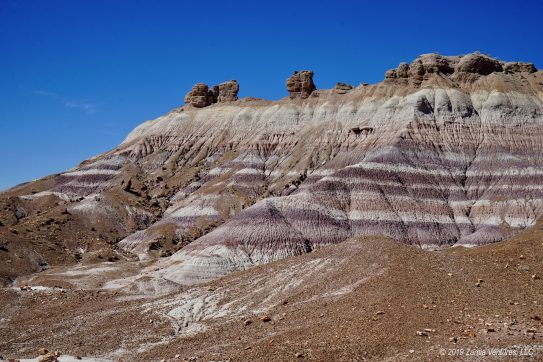
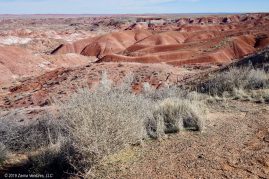
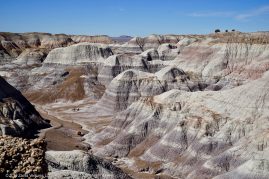
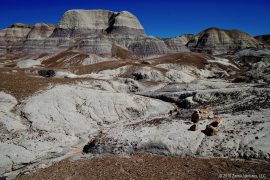
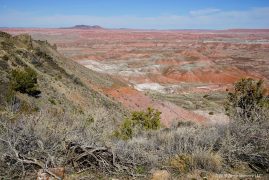
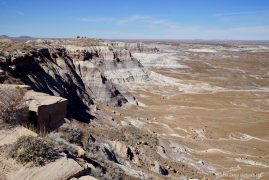
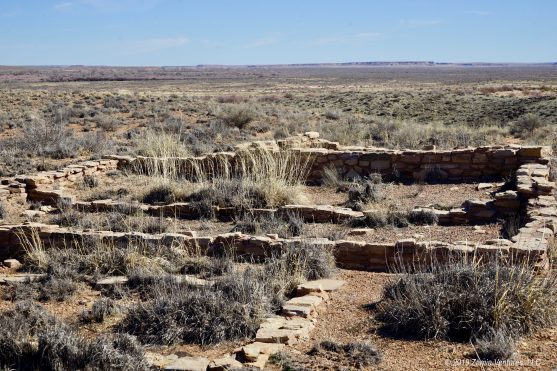
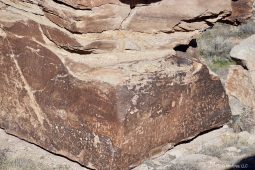
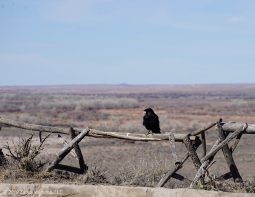
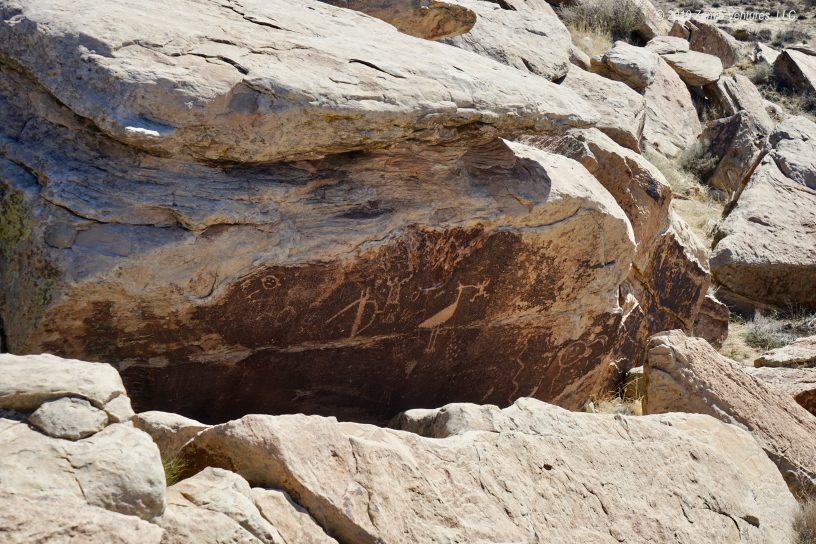
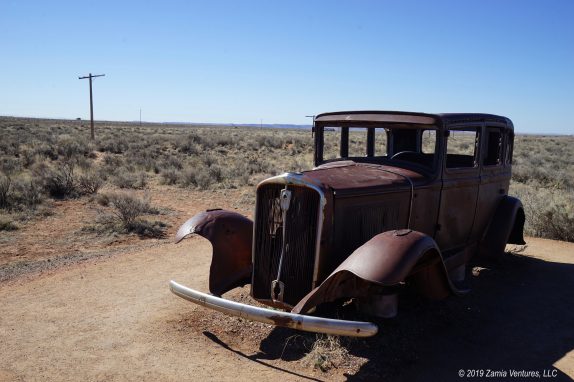
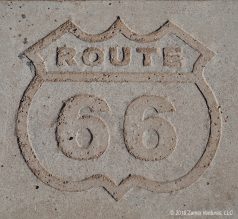
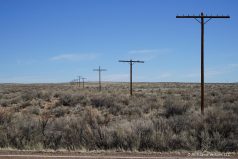
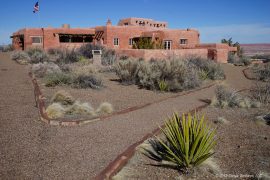
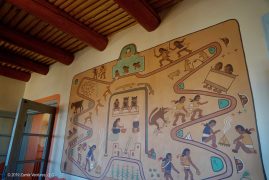
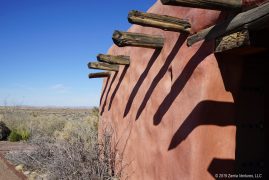
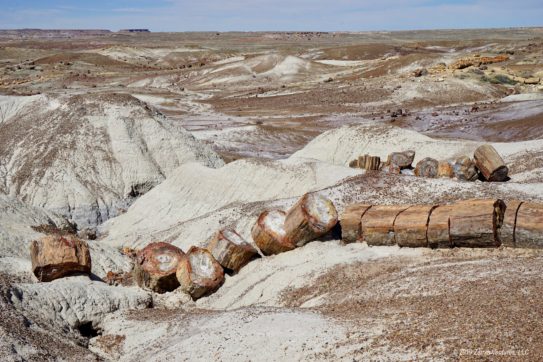
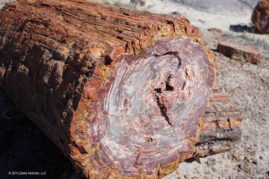
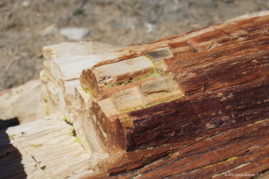
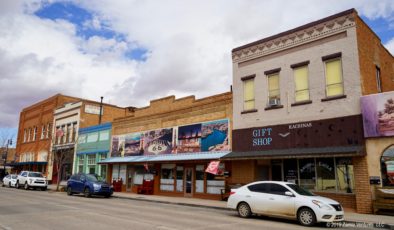
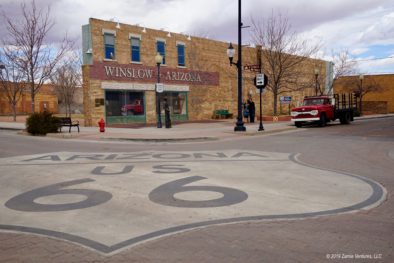
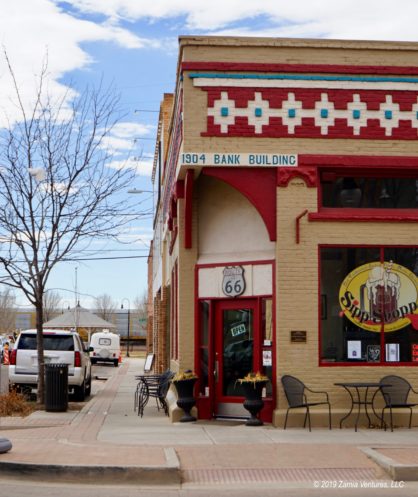
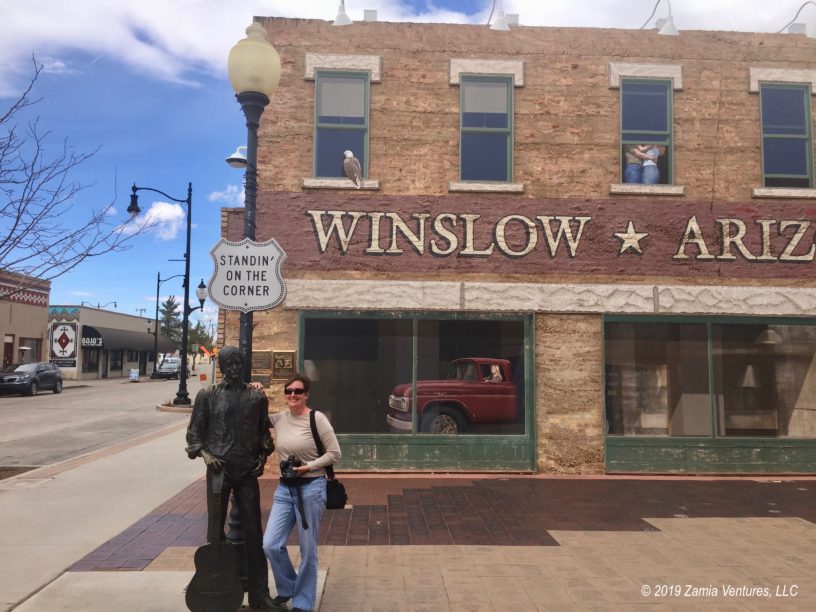
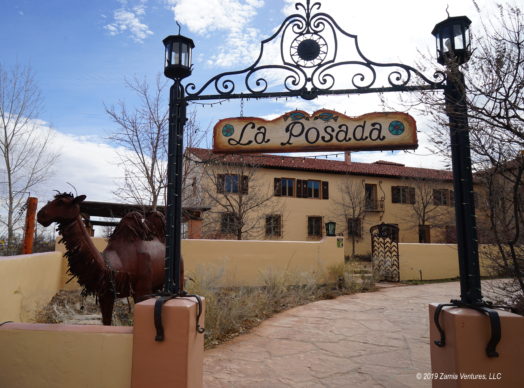
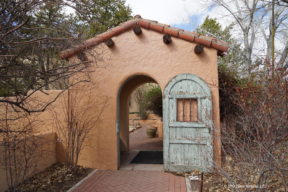
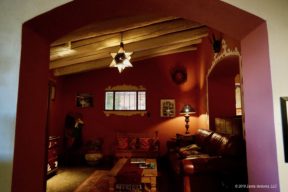
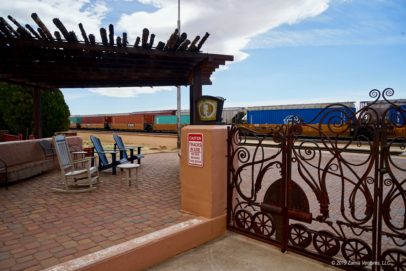
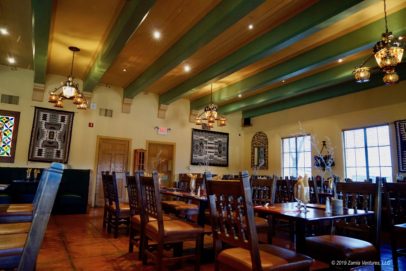
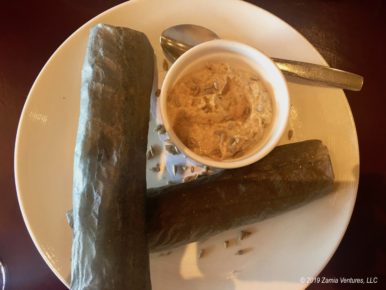
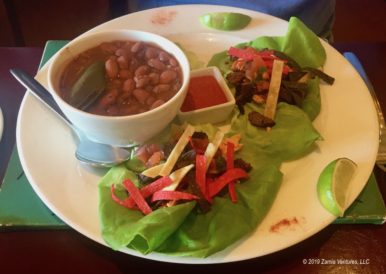
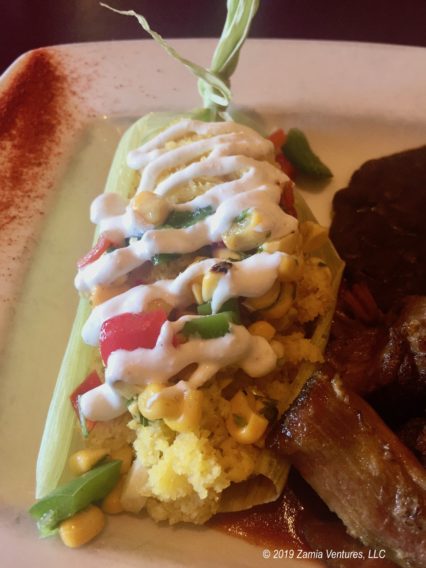
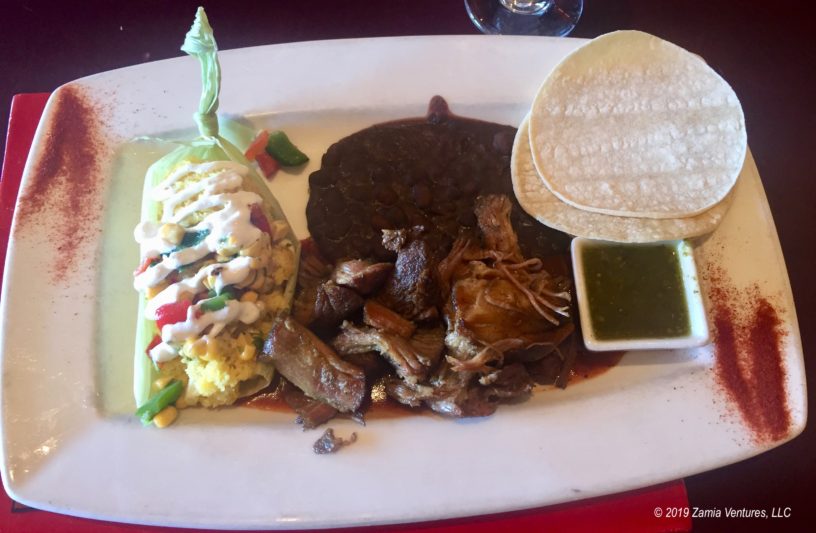
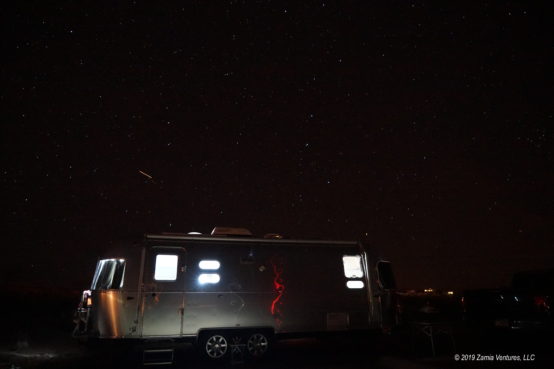
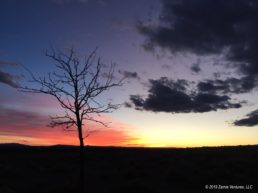
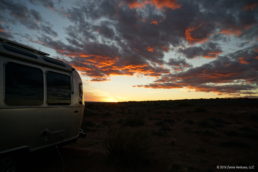
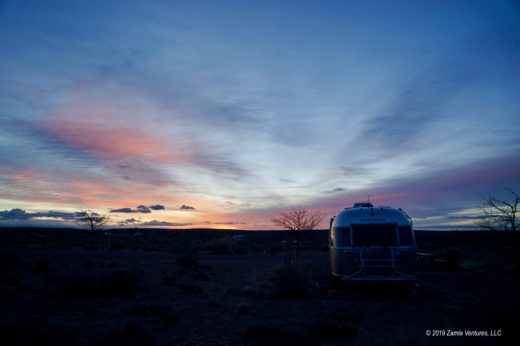
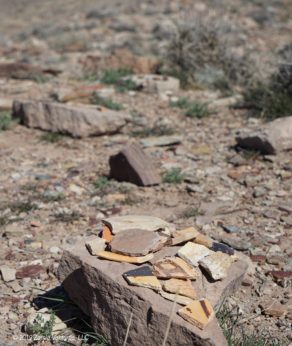
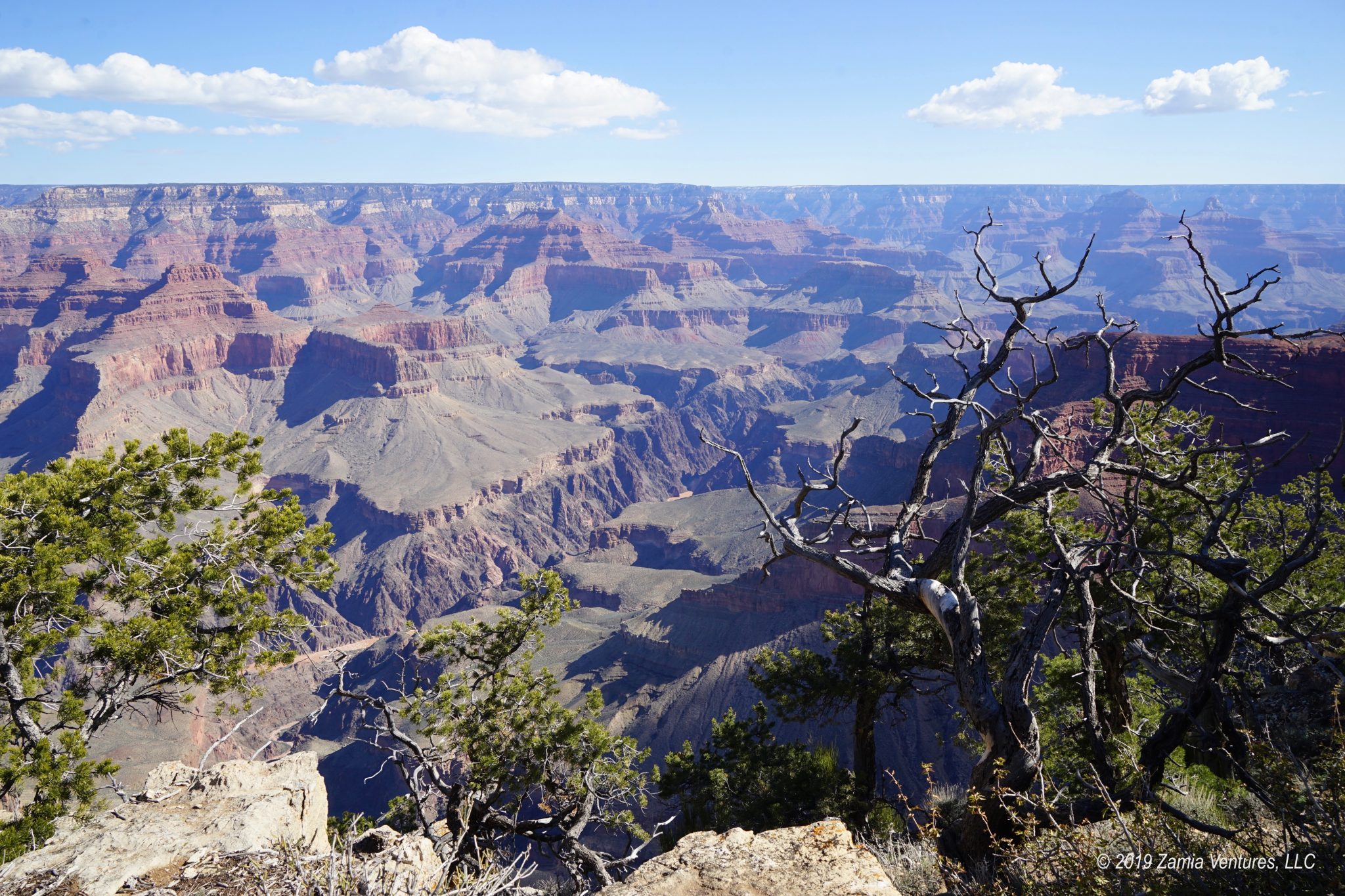
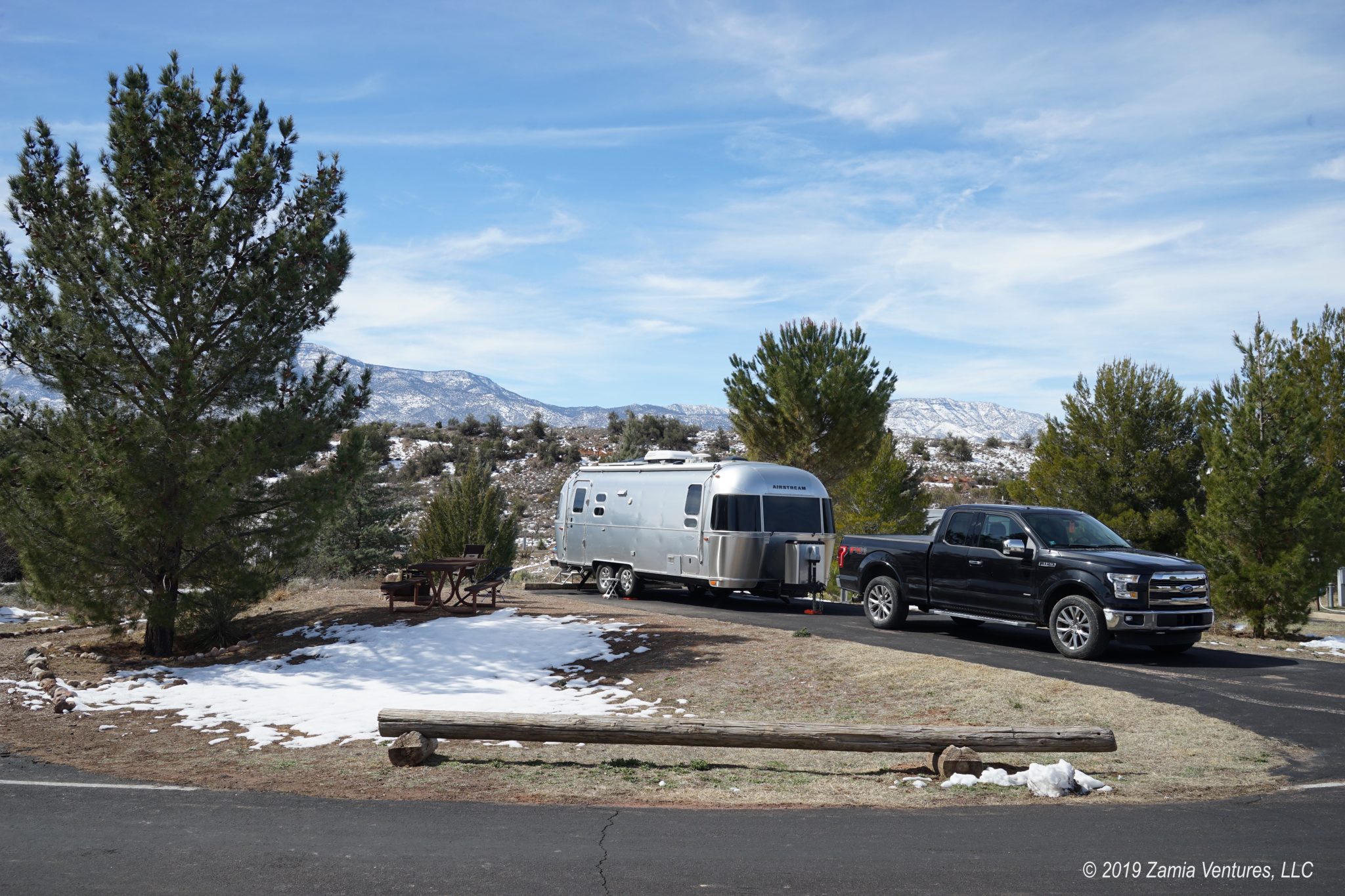
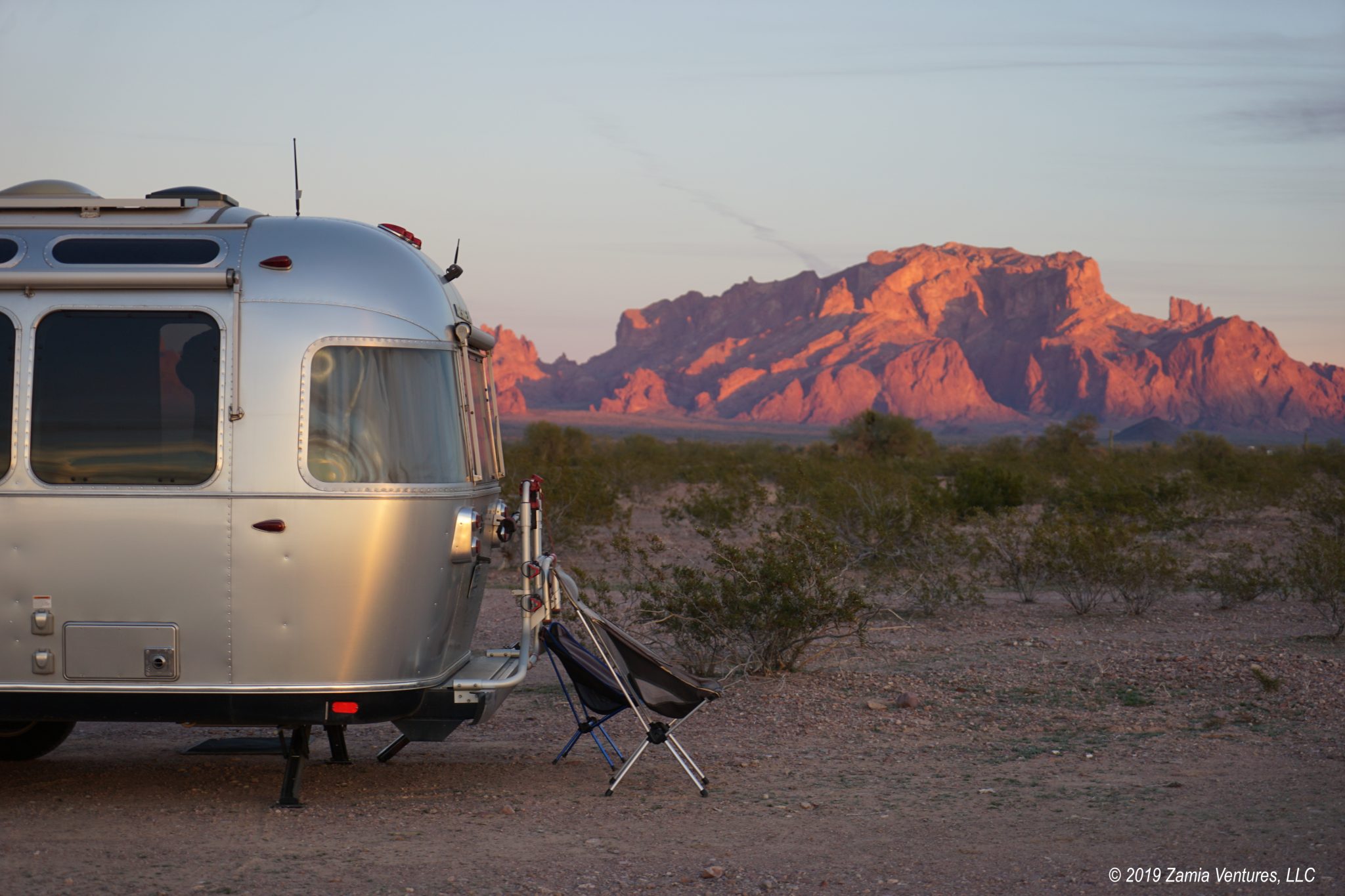
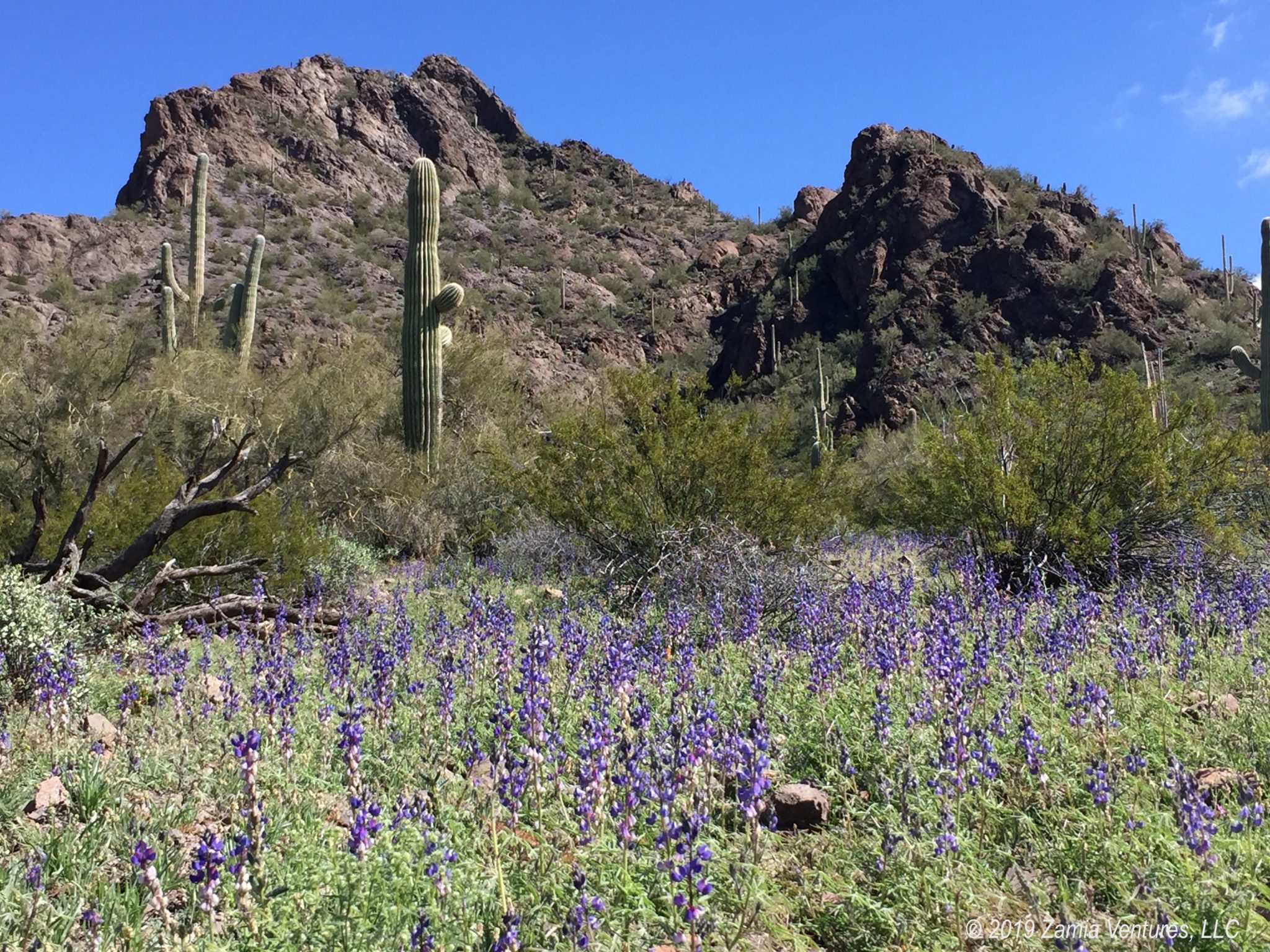
Wow… this is all so…. familiar. Weird…. Hahaha. Good timing on the information about Petrified Forest National Park. If I’m being totally honest, we’re not exactly thrilled about petrified wood either, but like you, NPS parks haven’t let us down yet!! There’s certainly no shortage of interesting scenery there as evidenced by your colorful and beautiful photos!
I have a feeling that all travelers take literally the exact same pictures of Winslow and have virtually identical experiences. At least at Petrified Forest NP there are great landscapes in every direction! And the petrified wood was even more interesting that expected.
“So much for the trees,” LOL! I’m sure you’re finding plenty now in Prescott.
This is a great post and wonderful photos on one of our favorite little quirky, lesser-known areas of the country. We were also surprised by the colorful beauty of the Petrified Forest. My first experience of it many years ago was in August, which is NOT the time to be there. But several years ago we returned in spring and it was gorgeous. We also are intrigued by Mary Coulter’s work and thoroughly enjoyed La Posada and lunch at the Turquoise Room. I had no idea that Fred Harvey Hotels are now Xanterra!!
We always love stopping at Homolovi for a day or two when we’re in the area. We’ve never been there for those kinds of winds, though!
If you’re still in Flagstaff, the Northern Arizona Museum is fabulous, and so is lunch at the quirky little Cafe Daily Fare. Both are on our blog.
Aargh, I meant trees in Flagstaff, not Prescott. I’m so engrossed in helping my folks that it’s astonishing I can write anything coherent right now. 🙂
Thanks for the tips! Out visit in Flagstaff will be impacted by the expected snow storm, but we’re hoping to still have time to do all the things we intended during this stay. If not, we’ll just have to come back!
I’m glad that you agree we pretty much exhausted the activities in the Winslow area. I kept thinking we were missing something, but nope, that’s pretty much it.